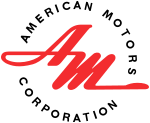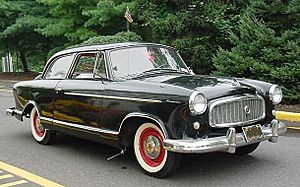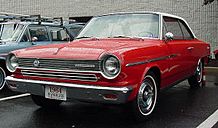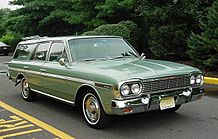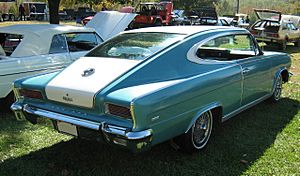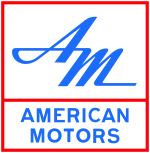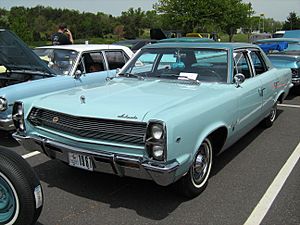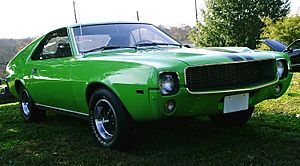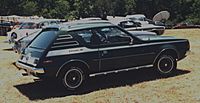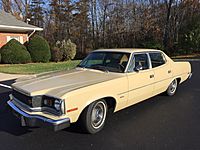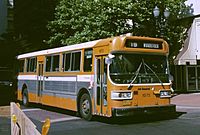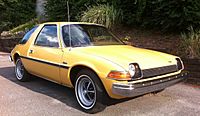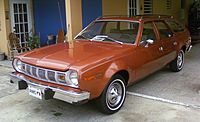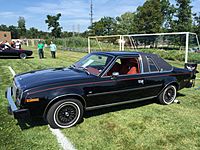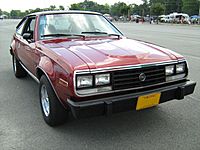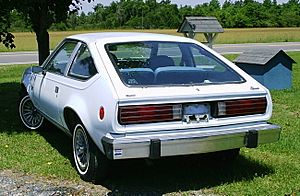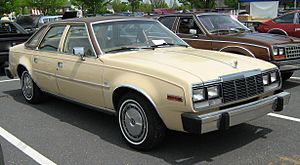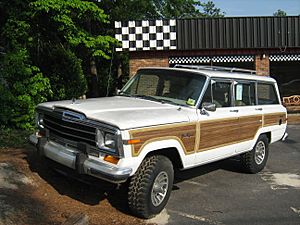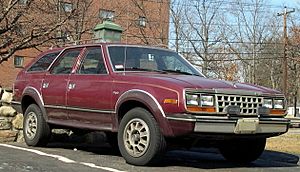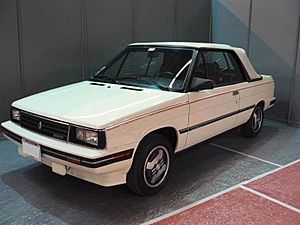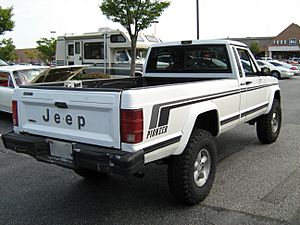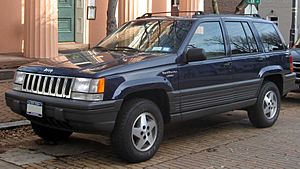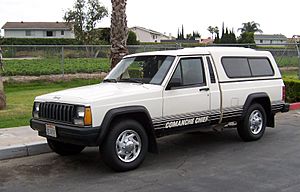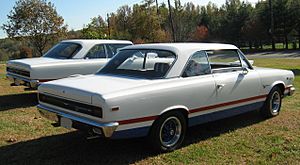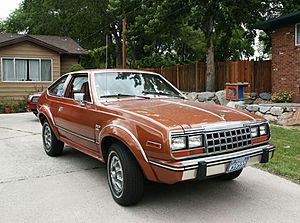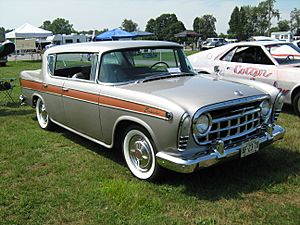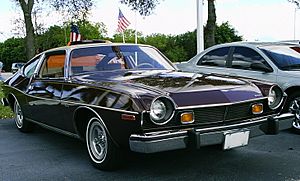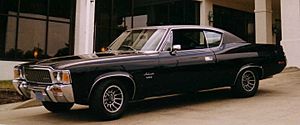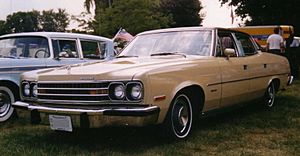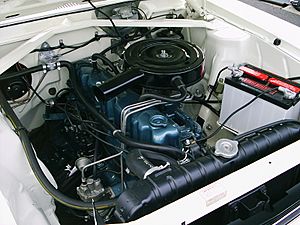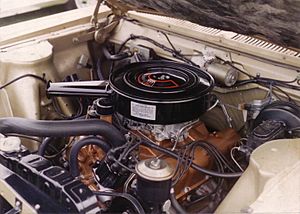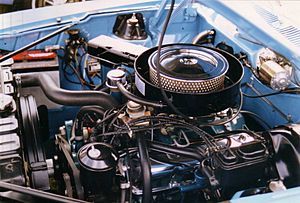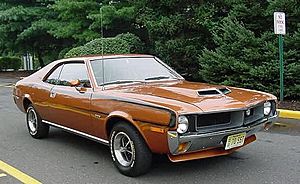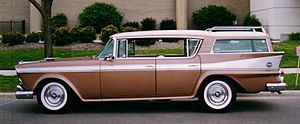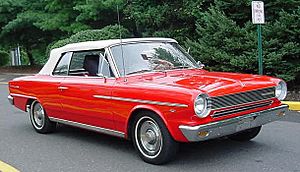American Motors Corporation facts for kids

Logo from 1970 until 1987
|
|
| Industry | Automotive |
|---|---|
| Fate | AMC was renamed Jeep Eagle Corporation then merged into Chrysler in 1990. |
| Predecessor |
|
| Successor |
|
| Founded | May 1, 1954 |
| Founder | George W. Mason |
| Defunct | June 20, 1988 |
| Headquarters | American Center 27777 Franklin Rd Southfield, Michigan, 48034 U.S. |
|
Key people
|
|
| Products |
|
| Brands | |
| Subsidiaries |
|
American Motors Corporation (AMC), often called American Motors, was an American company that made cars. It was created on May 1, 1954, when two companies, Nash-Kelvinator Corporation and Hudson Motor Car Company, joined together. At the time, this was the biggest company merger in U.S. history.
American Motors competed with other car makers like Studebaker and Packard. But their biggest rivals were the "Big Three" car companies: Ford, General Motors, and Chrysler.
American Motors made many types of cars. They built small cars like the Rambler American, Hornet, Gremlin, and Pacer. They also made bigger cars such as the Ambassador and Matador. For those who liked speed, they had "muscle cars" like the AMX and Javelin. They even made early four-wheel drive vehicles like the Eagle and Jeep Wagoneer, which were some of the first crossovers in the U.S.
The company was known for being smart. It found ways to make cars that bigger companies weren't focusing on. Their main designer, Dick Teague, was very good at making great car designs even with a small budget.
After some successful years, a French car company called Renault bought a large part of American Motors in 1979. Later, in 1987, Chrysler bought the entire company.
Contents
- How American Motors Started in 1954
- Developing Cars in the 1950s
- Changes in the 1960s
- Car Developments in the 1970s
- Financial Challenges and Renault Partnership
- Car Developments in the 1980s
- 1985 and the Final Buyout
- Leadership at American Motors
- What American Motors Left Behind
- International Impact
- Former Brands and Factories
- American Motors Passenger Cars
- American Motors Engines
- Collectible American Motors Cars
- See Also
How American Motors Started in 1954
In January 1954, Nash-Kelvinator Corporation began to buy the Hudson Motor Car Company. This big deal created the new American Motors Corporation. It became the fourth-largest car company in the U.S.
George W. Mason, who was in charge of Nash, became the president and CEO of the new company. He believed that smaller car companies needed to join forces to compete with the "Big Three" (Ford, GM, and Chrysler). These bigger companies were having a price war, which made it hard for smaller companies to survive.
One immediate benefit of the merger was that Hudson could lower its car prices. This happened because they could now buy parts and produce cars together with Nash, saving money.
Sadly, George W. Mason passed away in 1954. George W. Romney took over as the new leader. Romney decided to focus American Motors on making smaller, more fuel-efficient cars.
Developing Cars in the 1950s
Combining Car Models
In 1955, American Motors brought together the Nash and Hudson car lines. They started making both brands at the Nash factory in Kenosha, Wisconsin. The old Hudson factory in Detroit was then used for military projects.
Popular models like the Nash Rambler were sold under both the Nash and Hudson names. These cars looked almost the same, with only small differences like hubcaps and nameplates.
The larger Nash and Hudson cars didn't sell very well. American Motors lost money each year. Because of this, George Romney decided in 1956 that the company's future was in the smaller Rambler cars.
Romney stopped making the big cars and focused only on the Rambler line. Sales of the new Ramblers were slow at first. But Romney launched a huge public relations effort, traveling across the country to talk about the Rambler.
In 1958, Rambler sales soared, and American Motors made a profit for the first time since it was formed. The Nash and Hudson brands were stopped. Rambler became its own car brand and the main focus of the company. The small, British-built Metropolitan car also continued to sell well until 1961.
American Motors even brought back an older, smaller Rambler model from 1955. They called it the new Rambler American. This gave Rambler a full lineup of compact cars.
The "Dinosaur-Fighter" Strategy
Rambler sales grew quickly in the late 1950s. This was partly because American Motors focused on compact cars. They also advertised a lot, even sponsoring the popular Walt Disney anthology television series. George Romney himself appeared in TV commercials for Rambler.
While the "Big Three" car makers were making bigger and bigger cars, American Motors chose a different path. Romney called it the "dinosaur-fighter" strategy. He focused on compact, fuel-efficient cars, which was smart long before there was a big need for them.
This strategy helped Rambler become known for building strong, affordable cars. American Motors also decided not to change their car styles every year like the Big Three did. This saved money.
In 1959, American Motors announced a big expansion of its factory in Kenosha. They believed that smaller cars would become very popular in the U.S.
The company also started looking into cars that didn't use gasoline. In 1959, American Motors and Sonotone Corporation worked together to explore making an electric car. This car would use special batteries that could recharge quickly.
In 1959, American Motors hired a talented designer named Dick Teague. He later became the main designer for the company.
Changes in the 1960s
New Ideas and Features
American Motors introduced many new features in the 1960s, often before the "Big Three" did.
For example, in 1962, the Rambler Classic came with a special brake system. This system allowed the car to stop even if one part of the brakes failed. Only Cadillac had this safety feature at the time, six years before it became required by law.
Rambler also offered front seats that could recline in 1964. This was nearly ten years before other major car makers offered it. They also made disc brakes standard on some models in 1965, making them one of the first American cars to do so.
In the early 1960s, sales were strong. Ramblers were the third best-selling cars in the U.S. in both 1960 and 1961. The company was making good profits and had no debt. They even agreed to a profit sharing plan with their workers, which was new for the car industry.
However, in 1962, George Romney left American Motors to become the Governor of Michigan. Roy Abernethy, who was in charge of sales, took over as CEO.
By 1964, Studebaker had stopped making cars in the U.S. This left the "Big Three" and American Motors as the main car makers in North America.
Abernethy believed that American Motors should make bigger, more expensive cars. He wanted to keep customers who started with Ramblers as they wanted to buy fancier cars. In 1965, American Motors launched new, longer Ambassador models and convertibles. They also added a new fastback car called the Marlin.
Difficult Choices
Making new car styles every year cost a lot of money. American Motors started to fall behind in sales. They launched new designs for their larger cars in 1966, which looked good. But there were problems with quality, and rumors spread that the company was in financial trouble.
Despite these issues, American Motors' international sales were growing. They sold many cars in Canada, Europe, and Latin America.
Abernethy also wanted to stop focusing on the Rambler brand. He felt people thought of Rambler as only an "economy car," which hurt sales of American Motors' other, more expensive models. So, in 1966, the Ambassador and Marlin cars were branded only as American Motors products.
A completely new design for larger 1967 models cost American Motors another $60 million. This was a huge amount for the company. These new models shared fewer parts, making them more expensive to build.
American Motors also worked with Gulton Industries to develop an electric car in 1967. They even showed a 1969 Rambler station wagon powered by a new battery system. This led to other experimental electric cars like the Amitron and Electron.
By early 1967, the company's financial situation was very bad. Roy Abernethy was replaced by Roy D. Chapin Jr.. Chapin quickly made changes. He lowered the price of the Rambler to compete with the Volkswagen Beetle. He also made air conditioning standard on all 1968 Ambassador models, a first for a U.S. car maker.
The company also introduced exciting new cars for the "muscle car" trend, like the AMX and the sporty Javelin. To get more money, American Motors sold its Kelvinator Appliance division in 1968. This meant American Motors would now only make cars.
The Rambler brand was stopped in the U.S. in 1968, though it continued to be used in other countries like Mexico until 1983. From 1970, all American Motors passenger cars used the "American Motors" name and a new company logo.
Car Developments in the 1970s
Jeep
In 1970, American Motors made a big decision to buy the Kaiser Jeep division for $70 million. This was a risk, but Chapin believed that Jeep vehicles would be a good fit for American Motors. The "Big Three" car makers weren't making Jeeps, so there was no competition there. American Motors gained the famous Jeep brand of trucks and SUVs, as well as government contracts for military Jeeps. This part of the company was later called AM General.
Hornet and Gremlin
In 1970, American Motors launched the Hornet line of compact cars. The Hornet and the later Gremlin shared many parts. The Gremlin was the first small car built in North America. Over 670,000 Gremlins were sold from 1970 to 1978. The Hornet became American Motors' best-selling car, with over 860,000 units sold.
For a while, you could even order both the Hornet and Gremlin with Levi's denim interiors!
Matador
The new, mid-sized AMC Matador replaced the Rebel in 1971. In 1972, American Motors won a contract to supply cars for the Los Angeles Police Department. Matadors were used as police cars, taxis, and government vehicles.
In 1973, American Motors also made a deal to build Wankel engines for cars and Jeeps.
From 1974, the Matador sedan and station wagon got a new, boxier look. This second version was sold until 1978.
Ambassador
From 1970, the Rebel and Ambassador cars looked very similar from the middle back. The Ambassador remained American Motors' fancy model, with more comfort features and standard air conditioning. The front of the Ambassador was redesigned and made longer, becoming the biggest Ambassador ever. This happened just as the 1973 Arab Oil Embargo caused gasoline shortages. Sales of all large cars dropped because of economic problems and rising gas prices. The Ambassador was stopped after the 1974 model year.
Matador Coupe
In 1974, the Matador two-door car was replaced with a sleek, new two-door coupe. This car was praised for its design and was even called "Best Styled Car of 1974" by Car and Driver magazine. Almost 100,000 of these coupes were sold over five years.
Metropolitan Buses
In 1974, American Motors' AM General company started building city buses called Metropolitan buses. They built over 5,400 buses, including electric trolley buses, until 1979.
Pacer
The AMC Pacer, launched in March 1975, was a new and unique car. It was marketed as "the first wide small car" and was designed to feel as comfortable as a big car.
The Pacer was originally planned to use a special rotary engine. But because of rising gas prices, American Motors used its existing six-cylinder engines instead. The Pacer was expensive to make, and sales dropped after the first two years.
Developing the Pacer and Matador Coupe cost a lot of money. This meant American Motors couldn't update its more popular Hornet and Gremlin cars. By the late 1970s, the company had older car models that struggled to compete.
In 1977, the Gremlin got new headlights and a new look. To save fuel, American Motors offered it with a more fuel-efficient Volkswagen-designed engine.
The AMX name returned in 1977 as a sporty package for the Hornet hatchback.
Concord
For 1978, the Hornet car was redesigned and renamed AMC Concord. American Motors aimed this car at the "premium compact" market. They focused on making it comfortable and luxurious inside.
The Gremlin also got some updates, including a sports package. Sales of the Matador cars were falling, so their V8 engine option was removed. Matador production stopped at the end of 1978.
Spirit
In 1979, the Spirit car replaced the Gremlin. A new fastback version of the Spirit was very popular.
Pacer production stopped in December 1979.
In 1979, American Motors celebrated its 25th anniversary. They released "Silver Anniversary" editions of the AMC Concord and Jeep CJ. Jeeps were a big part of the company's sales and profits. They also introduced the LeCar, which was a U.S. version of the small, fuel-efficient Renault 5.
The Concord and Spirit models were stopped after 1983.
Financial Challenges and Renault Partnership
Late 1970s
In 1977, American Motors was facing financial difficulties. However, sales of Jeep vehicles were strong, which helped the company.
In October 1977, Gerald C. Meyers became the new Chairman and CEO.
In March 1978, American Motors and Renault, a French car company, announced a big agreement to work together. A month later, American Motors stopped making city buses.
American Motors lost money on its regular cars in 1978. But strong Jeep sales helped the company make an overall profit.
A year later, American Motors made a deal with Renault. American Motors would get a large amount of money and the right to build the Renault 5 car. In return, Renault bought a 22.5% share of American Motors. This wasn't the first time they worked together; Renault had assembled Rambler cars in France in the early 1960s.
In 1979, American Motors announced a record profit, despite economic problems and rising gas prices.
The 1980s
In 1980, all American Motors cars received a new rust-proofing process. This helped protect the cars from rust and came with a 5-year warranty.
However, a drop in Jeep sales and rising energy prices caused financial problems for American Motors. The company's older factories in Kenosha, Wisconsin, were also not very efficient.
In early 1980, banks refused to lend American Motors more money. The company needed new, modern cars but didn't have the funds. So, they turned to Renault for a large loan. By the end of 1980, American Motors' sales had dropped significantly. The company warned shareholders that it could go out of business if they didn't approve Renault buying a majority share. On December 16, 1980, shareholders agreed to let Renault become the main owner.
By 1983, Renault owned 49% of American Motors. Some people saw this as the end of American Motors as a truly American car company.
With new owners and management, American Motors started building modern front-wheel drive cars designed by Renault at its Kenosha factory.
Car Developments in the 1980s
AMC Eagle
In 1979, American Motors introduced four-wheel-drive versions of the Spirit and Concord. This new line was called the AMC Eagle. Eagles quickly became very popular and are seen as one of the first "crossover SUVs." They sold best in areas with a lot of snow.
While the two-wheel-drive Spirit and Concord were stopped after 1983, the Eagle continued for five more years, only as a station wagon. From 1984, the four-wheel-drive Eagle was the only car sold under the American Motors brand. All other vehicles were branded Renault or Jeep. The last AMC Eagle was built on December 14, 1987.
Renault Alliance, Encore and GTA
The Renault Alliance was the first car made jointly by American Motors and Renault. Launched in 1983, the Alliance was a small, front-wheel-drive car based on the Renault 9. American Motors built it in Kenosha. It was sold as a Renault, and some cars also had American Motors badges. It came as a sedan and later as a convertible.
The hatchback version, called the Renault Encore, was introduced in 1984. For its last year in 1987, a high-performance version of the Alliance was sold as the Renault GTA.
The Alliance won several awards, including "Motor Trend Car of the Year." It was praised for being well-built. However, sales were hurt because there were only a few body styles, and the car wasn't fully suited for the U.S. market. Also, problems with dealership support led to quality issues and high warranty costs.
Production of the Alliance and GTA ended in June 1987.
Jeeps
Even more important for American Motors' future was the launch of new, compact Jeep Cherokee and Wagoneer models in 1983 for the 1984 model year. These new Jeeps were designed to be lighter and more fuel-efficient.
The new Cherokee was much lighter and smaller than the older model. But thanks to its strong unibody design, it kept most of its interior space. It also had better fuel economy and was excellent for off-road driving.
American Motors expected to sell 40,000 Cherokees and Wagoneers, but they sold 75,000 in the first year! These smaller Jeeps created a new market for what we now call sport utility vehicles (SUVs).
The Cherokee initially used a four-cylinder engine. In 1987, a new 4.0-liter six-cylinder engine was introduced. This engine became known for its reliability and toughness. Chrysler kept this engine after buying American Motors, and it was used in Jeeps until 2006. The Cherokee itself was built by Chrysler until 2001 in the U.S.
Other Jeep designs continued after the Chrysler buyout. These included the large Jeep Grand Wagoneer SUV and the Jeep Comanche compact pickup truck, which came out in 1986.
Production of the large Jeep pickups stopped after 1987. The Grand Wagoneer was stopped after 1991, and the Comanche after 1992.
1985 and the Final Buyout
Market and Leadership Changes
In 1985, the car market changed. Gas became cheaper, and people wanted bigger, more powerful cars again. American Motors was not ready for this.
At the start of 1985, Renault's chairman in France was replaced due to big losses. Renault had invested a lot of money in American Motors.
In April 1985, American Motors' chairman resigned. New leaders took over. They sold the lawn care division and made a deal to build Jeeps in China. The profitable AM General division, which made military vehicles, was sold to another company. This happened because the U.S. government didn't want a foreign government (France) to own a big part of an important defense supplier.
Dick Teague, American Motors' design vice president for 26 years, also left the company. He was responsible for many famous AMC and Jeep designs.
Problems at Renault and a Sad Event
In France, Renault continued to have financial problems. Their investment in American Motors, including building a new factory in Canada, forced them to close some French plants and lay off many workers.
Renault's new chairman, Georges Besse, believed in the company's future in North America. He pointed to the new, advanced factory in Canada and the popular Jeep vehicles. It seemed American Motors was getting closer to making a profit.
Sadly, on November 17, 1986, Georges Besse passed away unexpectedly. This event led to changes in Renault's plans for American Motors.
Chrysler Buys American Motors
Under pressure from Renault's leaders after Besse's death, Renault's new president, Raymond Levy, decided to sell the company's share in American Motors. Renault owned 46.1% of American Motors' stock. In 1986, American Motors lost money.
Chrysler had an agreement with American Motors to build some of Chrysler's larger cars. This existing relationship helped with the negotiations.
On March 9, 1987, Chrysler agreed to buy Renault's share in American Motors, plus all other shares, for about $1.5 billion.
Chrysler openly said they were mainly interested in three things:
- The Jeep brand, which was very famous.
- American Motors' new, modern factory in Bramalea, Canada.
- American Motors' network of 1,300 dealerships across the country.
With the sale complete, American Motors became the Jeep-Eagle division of Chrysler.
The sale happened when many in the car world were excited about American Motors' upcoming 1988 car lineup. American Motors' financial situation seemed to be improving. Chrysler bought American Motors when the company appeared to be in a good position with its new products.
Chrysler CEO Lee Iacocca especially wanted the Jeep brand, particularly the ZJ Grand Cherokee that Jeep engineers were developing. This car later became very profitable for Chrysler.
The buyout also included other good things for Chrysler. The new factory in Bramalea, Ontario, gave Chrysler a chance to make more cars at a great price. Chrysler also gained American Motors' dealership network and its talented management team.
American Motors was renamed Jeep Eagle Corporation on August 25, 1988. It fully merged with Chrysler by March 29, 1990.
Leadership at American Motors
1954: George W. Mason
The merger that created American Motors in 1954 was led by George W. Mason, the president of Nash-Kelvinator. He wanted to combine the strengths of Nash and Hudson to compete with the much larger "Big Three" car makers. Mason had also thought about merging with Packard, but that deal didn't happen.
Mason became the first CEO and president of American Motors. He chose George W. Romney as vice president and Roy Abernethy to lead sales.
1954–1962: George W. Romney
After Mason's sudden passing in 1954, Romney took over. He reorganized the company and decided to focus American Motors on a new line of small cars. Romney also stopped any further talks about merging with Studebaker-Packard.
By the end of 1957, the old Nash and Hudson car brands were gone. They were replaced by the Rambler and Metropolitan brands. The company struggled at first, but under Romney, Rambler sales grew quickly. By 1960, Rambler was the third most popular car brand in the U.S.
1962–1967: Roy Abernethy
George Romney left American Motors in 1962 to run for governor. Roy Abernethy became the new CEO. After two years of only making compact cars, Abernethy decided to shift American Motors back to making larger, more profitable cars like the Ambassador.
Ambassador sales increased a lot in 1965 and 1966. However, the huge costs of developing new cars and engines made it hard for American Motors to get enough money to keep going. The company started losing money. In 1967, Abernethy "retired" as CEO.
1967–1977: Roy D. Chapin Jr.
Abernethy was replaced by Roy D. Chapin Jr., the son of Hudson's co-founder. Chapin worked to make the company strong again. Designer Dick Teague found ways to save money by using common parts for several vehicles.
American Motors introduced new, sporty cars like the Javelin and AMX "muscle cars" starting in 1968.
In 1970, American Motors bought Kaiser's Jeep operations. This added popular utility vehicles to their business. In the early 1970s, the company also launched new compact car designs like the Hornet and Gremlin. Other new models included the Matador and Pacer.
1977–1982: Gerald C. Meyers
In 1977, Gerald C. Meyers became Chairman and CEO. He was the youngest top executive in the car industry at 49 years old. Meyers believed the company could survive by focusing on its four-wheel-drive vehicles and getting advanced technology.
Falling sales and tight finances led to the end of the Matador line in 1979 and the Pacer line in 1980. This left American Motors to focus mostly on its Hornet-based cars and the Jeep line. The innovative four-wheel-drive AMC Eagle, introduced in 1979, was one of the first true crossovers.
From 1980, American Motors partnered with France's Renault. This helped them get money and new small cars.
1982–1984: W. Paul Tippett Jr.
Meyers retired in 1982, and W. Paul Tippett Jr. became chairman. By this time, Renault controlled 46% of American Motors. Jose J. Dedeurwaerder, a manager from Renault, became the new president.
After the 1983 model year, American Motors focused only on four-wheel-drive cars. They stopped making two-wheel-drive cars. American Motors' factories were used to produce Renault-branded cars like the Alliance and Encore. In September 1984, Paul Tippet left, and Jose J. Dedeurwaerder became CEO.
1984–1986: Jose J. Dedeurwaerder
In 1985, Chrysler made a deal with American Motors to produce some of Chrysler's cars at American Motors' Kenosha plant. American Motors had extra factory space at the time.
1986–1987: Joe Cappy
In 1987, after developing new cars like the Medallion and the Eagle Premier, Renault sold its share in American Motors to Chrysler. Chrysler then offered to buy all remaining shares. American Motors was bought by Chrysler in August 1987.
The last CEO of American Motors, Joe Cappy, was in charge of combining the two companies quickly.
Renault left the U.S. market as a brand in 1987. So, the Renault Medallion was sold as an Eagle through the new Jeep-Eagle division of Chrysler. The Jeep and Eagle vehicles were mainly sold by former American Motors dealers. The American Motors name was last used on the Eagle Sports Wagon in 1988, then it was completely removed. The Eagle car brand was stopped by 1998.
What American Motors Left Behind
Business Ideas and Impact
American Motors had to be very creative for 33 years until Chrysler bought it in 1987. The lessons learned from American Motors helped Chrysler become stronger. Many of American Motors' ideas, strategies, and even some of its leaders helped Chrysler succeed.
American Motors was good at coming up with smart plans. They knew they were up against giant companies, so they had to be quick and clever. One key strategy was to let other companies supply parts they were better at making. This idea was later adopted by the "Big Three" car makers.
Even though it was small, American Motors introduced many new ideas to the car industry. From 1957, American Motors was the only U.S. car maker to dip all car bodies in primer paint to protect against rust. Other companies didn't start doing this until 1964.
The AMC Pacer, one of American Motors' most expensive new cars, had many features that were later used by car makers worldwide. These included its aerodynamic shape, roomy interior, and large windows for better visibility.
American Motors' four-wheel-drive vehicles helped create the modern SUV market. Classic Jeep models are still a standard in this area.
The purchase of American Motors was very important for helping Chrysler recover. According to Robert Lutz, a former president of Chrysler, buying American Motors turned out to be a "gold mine" for Chrysler. It helped Chrysler change its way of thinking and improve its operations.
After the buyout, Chrysler kept American Motors' engineering team. François Castaing, American Motors' lead engineer, became head of all engineering at Chrysler. He introduced American Motors' "platform team" approach, where small groups were responsible for an entire car. This helped cut down on bureaucracy and changed Chrysler's company culture.
The lessons learned from American Motors also helped General Motors. When GM faced problems in the early 2000s, they brought in new leaders, including Bob Lutz. He used ideas from American Motors' efficient operations to help GM.
Renault also learned from its investment in American Motors. The French company used similar strategies to help turn around the struggling Nissan car maker in Japan.
In 2009, the Italian car maker Fiat took over Chrysler. Some people compared this to the American Motors-Renault deal. But there were key differences. Fiat's CEO also became Chrysler's CEO and quickly combined the companies. Chrysler also became profitable again much faster than American Motors did for Renault.
In 2014, Fiat and Chrysler fully merged to create Fiat Chrysler Automobiles. Later, they merged with the French company PSA Group to form Stellantis in 2021.
What Cars and Parts Lived On
Chrysler brought back the "Spirit" name for one of its cars from 1989 to 1995. The car that was planned as the Renault Medallion was sold as the Eagle Medallion in 1988 and 1989. The new 1988 Renault Premier, which American Motors and Renault developed together, was sold by Chrysler as the Eagle Premier.
The Premier's design was much more advanced than anything Chrysler was building at the time. After some changes, the Eagle Premier became the basis for many of Chrysler's cars in the 1990s, like the Chrysler Concorde, Dodge Intrepid, and Eagle Vision. The platform from these cars is still used today for models like the Chrysler 300 and Dodge Charger.
Chrysler also brought back the Hornet name in 2023 for a Dodge car, which is a version of the Alfa Romeo Tonale.
Jeep Vehicles
Chrysler continued to sell the large Jeep Grand Wagoneer until 1991, keeping it almost exactly as American Motors had made it. The Jeep Comanche pickup truck stayed until 1992, and the Cherokee until 2001 in the U.S. Even though it came out in 1993, the Jeep Grand Cherokee was first developed by American Motors.
Some parts from American Motors were used as late as 2006. The Jeep Wrangler, which was the last new product American Motors introduced before the Chrysler deal, still used the AMC Straight-6 engine in some models. It also used the same "paddle" door handles that American Motors had used since 1968. Both were changed when the Wrangler was redesigned in 2007.
AM General, which American Motors sold in 1983, still builds the American Motors-designed Humvee for military use. AM General also built the civilian H1 and the H2 for GM.
Even today, Jeep still uses the American Motors-era logo that was introduced shortly after American Motors bought the brand in 1970.
International Impact
Starting in 1960, Roy D. Chapin Jr., who was in charge of American Motors' international business, worked hard to set up sales and assembly plants for American Motors vehicles around the world. In five years, he greatly increased foreign sales.
Chapin successfully started or restarted car assembly in many countries, including Argentina, Australia, Belgium, Mexico, New Zealand, and South Africa. He also increased exports to countries in Europe, the Middle East, and South America. The Rambler Classic even became the basis for Argentina's national car, the Torino.
When American Motors bought Kaiser Jeep in 1970, it also took over all existing international Jeep operations. These helped American Motors survive through the 1970s and 1980s.
Even though the Rambler brand was stopped in the United States after 1969, it continued to be used in other countries, with Mexico using it until 1983.
- American Motors cars built: Ambassador, Classic (from 1964), Jeep
- American Motors cars imported: Ambassador, Classic (1962–1963)
- American Motors cars built: Rambler Six, Rambler V8, Ambassador (1961–1963), Classic, American, Rebel (sedan and wagon), Matador (sedan and wagon), Javelin (1968–1972), AMX (1969 model only), Hornet (sedan), Matador Coupe X (1974 model only, built in 1976), Jeep (1980–1984)
- American Motors cars imported: Classic (hardtop), Ambassador (1970 only)
- American Motors cars built: Rambler Six (1957 only), Classic, American, Ambassador (until 1968), Rebel, Hornet, Gremlin, Concord, Jeep, Eagle, Spirit
- American Motors cars imported: Rambler Six, Rambler V8, Metropolitan (from U.K), Ambassador (after 1968), Matador, Javelin, AMX
- American Motors cars built: Classic
- American Motors cars built: Classic (from 1965), American (from 1965), Ambassador (from 1965), Rebel, Matador, Javelin, Hornet, Sportabout, Jeep
- American Motors cars built: Jeep (from 1978)
- American Motors cars imported: Classic, American, Ambassador, Rebel, Javelin, Hornet, Matador, Jeep
- American Motors cars built: Classic, Rebel (1967 only)
- American Motors cars imported: Jeep (by Renault 1980–1986), Javelin, Pacer (by private importers)
- American Motors cars built: Javelin (by Karmann)
- American Motors cars imported: Ambassador (from 1969), Rebel (from 1969), AMX (from 1969), Jeep (from 1977), Eagle
- American Motors cars built: Jeep
- American Motors cars built: American, Jeep
- American Motors cars built: Jeep
- American Motors cars imported: Eagle (1985–1989), Jeep Cherokee (XJ)
- American Motors cars built: Rambler Six, Rambler V8, Ambassador (1959 only), American, Classic, Rebel (sedan), Matador, Javelin, AMX, Hornet, Matador Coupe X, Gremlin, Pacer, Spirit, Jeep
- American Motors cars imported: Rambler Six (1957–1958), Rambler V8 (1957–1958)
- American Motors cars built: Rambler Six, Rambler V8, Classic, Rebel (sedan), Jeep
- American Motors cars imported: Metropolitan, Rebel (wagon), Rebel (hardtop), Ambassador (1970 only)
- American Motors cars imported: Ambassador, Classic, American, Rebel
- American Motors cars built: Jeep (from 1984)
- American Motors cars built: Classic, American, Rebel
- American Motors cars built: Classic, American, Javelin
- American Motors cars imported: Gremlin, Javelin, Pacer, Jeep
- American Motors cars built: American, Hornet
- American Motors cars built: Jeep (1974–1981)
- American Motors cars built: Jeep
- American Motors cars built: Classic, Javelin, Hornet, Jeep
- American Motors cars built: Metropolitan (by Austin)
- American Motors cars imported: Rambler Six, Rambler V8, Classic, Rebel, Ambassador, Matador, Javelin, Pacer (locally changed to RHD), Gremlin (locally changed to RHD)
Former Brands and Factories
Old Brands and Divisions
Over its history, American Motors bought or created, and then later sold, several special divisions. Some of these still exist today:
- Kelvinator, which made appliances, was sold by American Motors in 1968. It is now part of Electrolux.
- Jeep is now a brand under Stellantis. Many Jeep models kept their original designs and parts from American Motors well into the 1990s and 2000s.
- AM General is now owned by KPS Capital Partners.
- Wheel Horse Products Division, which made lawn care products, is now owned by the Toro Company.
- Beijing Jeep was started by American Motors in 1984 to make Jeeps for China. This company was later taken over by Chrysler and is now owned by Mercedes-Benz Group.
Factories and Locations
- American Motors World Headquarters (1954–1975) was in Detroit. In 1975, American Motors moved its headquarters to a new building in Southfield, Michigan, called the American Center. This building is still standing and is used for offices.
- Toledo South Assembly Plants and Toledo Forge were torn down by Chrysler in 2007.
- Brampton (formerly Bramalea) Assembly and Satellite Stamping Plants are still used by Chrysler. American Motors designed and built this large, modern factory, which opened in 1986. It now builds cars like the Chrysler 300 and Dodge Charger.
- Kenosha "Main" Plant was partly used by Chrysler for engine production. This plant closed in October 2010 and was later torn down.
- Canadian Fabricated Products Ltd. and Guelph Products were Canadian divisions that made car parts. They were sold by Chrysler in the 1990s.
- Coleman Products Corporation and Evart Products Co. made car parts like wiring and plastic pieces.
- The American Motors Proving Grounds in Burlington, Wisconsin, was American Motors' test track. It is now used by MGA Research for testing.
- Holmes Foundry, Ltd. was American Motors' factory for casting engine blocks in Canada. Chrysler closed it in 1988.
- Kenosha "Lakefront" Plant and Milwaukee Body Plant were old American Motors factories that were torn down and redeveloped.
- Danforth Ave (Toronto, Ontario) Plant and Tilbury, Ontario Assembly Plant were older factories inherited from Nash and Hudson that were later closed.
- Brampton Assembly Plant (an older one) in Canada was opened by American Motors in 1960. It was closed in 1994 and later torn down.
American Motors Passenger Cars
- Small Cars (Subcompact)
- 1955–1962: Metropolitan
- 1970–1978: AMC Gremlin
- 1979–1983: AMC Spirit
- 1981–1983: AMC Eagle (SX/4 and Kammback)
- 1983–1987: Renault Alliance
- 1984–1987: Renault Encore
- 1987 only: Renault GTA
- Compact Cars
- 1955–1956: Nash/Hudson Rambler
- 1956–1957: Rambler Six/Rambler Rebel
- 1958–1969: Rambler American
- 1968–1970: AMC AMX
- 1968–1974: AMC Javelin
- 1970–1977: AMC Hornet
- 1975–1980: AMC Pacer
- 1978–1983: AMC Concord
- Crossover
- 1980–1988: AMC Eagle
- Mid-size Cars
- 1958–1960: Rambler Six/Rambler Rebel
- 1961–1966: Rambler Classic
- 1958–1964: Rambler Ambassador
- 1965–1966: Rambler/AMC Marlin
- 1967–1970: Rambler/AMC Rebel
- 1971–1973: AMC Matador
- Full-size Cars
- 1955–1956: Hudson Wasp
- 1955–1956: Nash Statesman
- 1955–1957: Hudson Hornet
- 1955–1957: Nash Ambassador
- 1965–1974: Rambler/AMC Ambassador
- 1967: AMC Marlin
- 1974–1978: AMC Matador (sedan and wagon)
- 1988–1992: Eagle Premier
American Motors Engines
American Motors used various engines in its cars and Jeeps over the years:
- Early Engines (1954–1956): Included Nash six-cylinder engines and V8 engines built by Packard.
- Rambler/AMC Engines (1956–1966): Used Rambler and AMC six-cylinder engines, and AMC V8 engines.
- Later Engines (1967–1970): Continued with AMC six-cylinder and V8 engines, including the 304, 360, and 390 cubic inch V8s.
- 1971–1980: Added a Volkswagen-designed four-cylinder engine, and continued with AMC six-cylinder and V8 engines.
- 1980s Engines: Used a Pontiac four-cylinder engine and AMC six-cylinder engines. Later, new AMC four-cylinder and six-cylinder engines were introduced.
- Renault Engines (1987–1989): Some models used a PRV V6 engine from Renault.
Jeep vehicles also used engines from other companies like Buick and Chevrolet.
Collectible American Motors Cars
Some American Motors models are very popular with car collectors today. These include the Javelin, AMX, and special performance cars like the 1957 Rambler Rebel and the 1970 Rebel Machine. These cars were made in smaller numbers, which makes them rare and valuable.
For example, the AMC AMX is becoming very popular in the "muscle car" market. It's a great choice for collectors who want a cool muscle car without the very high prices of some other brands.
Car experts say that the "Wow! Factor" is important for collectors. This means how much a car makes people say "Wow!" when they see it. American Motors cars often have this "Wow! Factor." For example, a bright red 1969 AMX can attract more attention than some expensive Ferraris.
Many American Motors cars, especially from the 1970s, are now considered "future collectibles." The AMC Gremlin, for instance, has a strong fan base. It's also relatively inexpensive to fix and restore because it shares parts with other AMC models.
There are active clubs for Rambler and American Motors car owners in the U.S. and other countries.
|
See Also
 In Spanish: American Motors Corporation para niños
In Spanish: American Motors Corporation para niños
- Amitron and Electron – Experimental battery-powered city cars designed by American Motors.
- AMC/Jeep Transmissions
- AMC 20
- Amco, American Motors, Inc. of New York City, active from 1917 until 1922.


